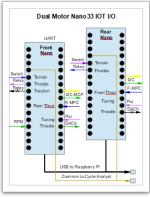HillCruiser
10 W
- Joined
- Jan 19, 2022
- Messages
- 81
The Cycle Analyst throttle input is steady as a rock using the analog output of the nano33; I'm sold on these little boards.
I also managed to get the throttle signal of one board to be read from the other board.
(First I tried to parallel the nano output; both to the CA and the other nano's analog input but couldn't get it to work.)
So instead, I used MCP4725 boards (analog output via I2C) to take one's board throttle counts to an analog input of the other board.
This provides near instantaneous coordination between the front and the rear motors
It also frees up the serial port 1 on each nano so I ordered a 5-3.3v level adjuster and will again try to bring the Cycle Analyst's
log stream directly in...

I also managed to get the throttle signal of one board to be read from the other board.
(First I tried to parallel the nano output; both to the CA and the other nano's analog input but couldn't get it to work.)
So instead, I used MCP4725 boards (analog output via I2C) to take one's board throttle counts to an analog input of the other board.
This provides near instantaneous coordination between the front and the rear motors
It also frees up the serial port 1 on each nano so I ordered a 5-3.3v level adjuster and will again try to bring the Cycle Analyst's
log stream directly in...



